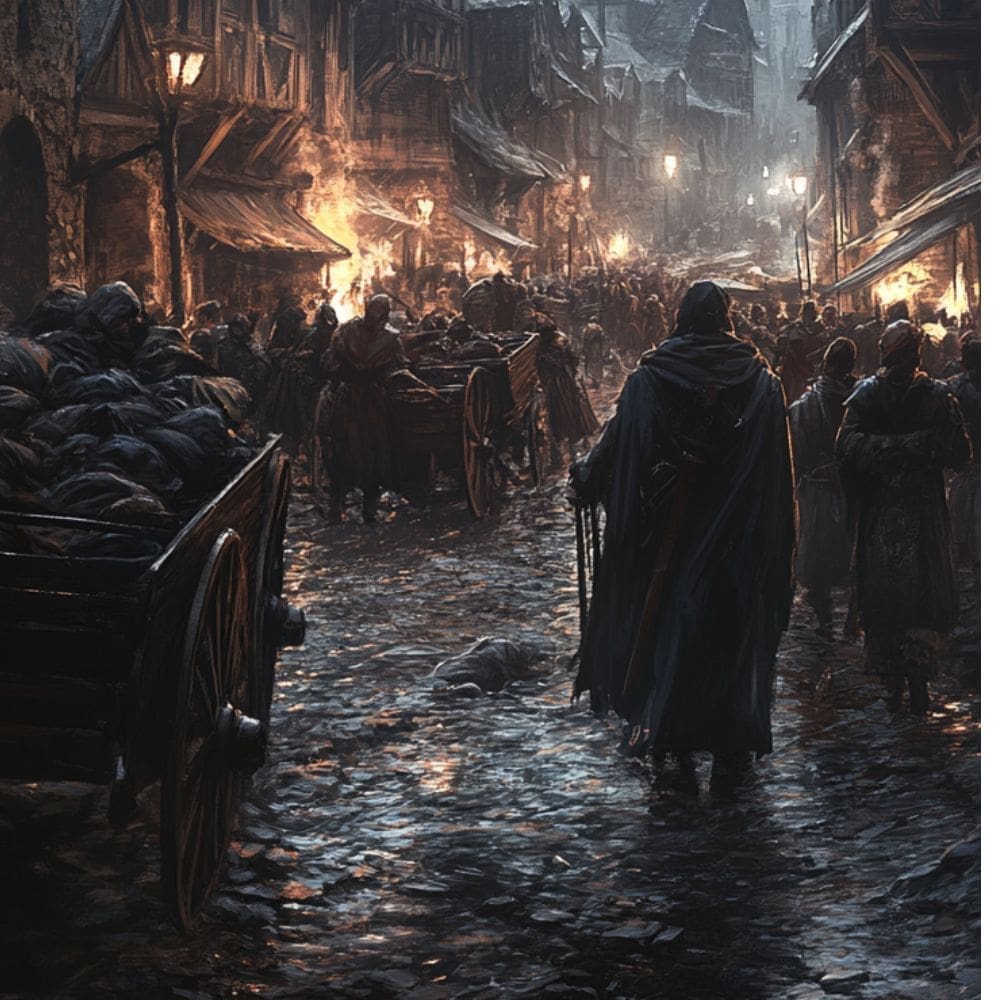
A Turning Point in History
The Black Death, one of the deadliest pandemics in human history, swept through Medieval England in the mid-14th century. It caused a profound impact on society, economy, and culture. This devastating event, which killed millions across Europe, struck England with particular force, wiping out nearly half of the population in some areas. The plague altered the course of history, leaving behind deep scars but also shaping the future in ways no one could have predicted.
The Arrival of the Black Death in England
In the autumn of 1348, the Black Death made its grim entrance into England, likely arriving through the bustling port of Melcombe in Dorset. The disease, caused by the bacterium Yersinia pestis, spread swiftly through the country, following trade routes, and infecting towns and villages. It is thought that the plague arrived from continental Europe, where it had already wreaked havoc.
The disease presented itself in three main forms: bubonic, pneumonic, and septicemic. Bubonic plague, the most common, was characterised by painful swellings known as buboes, fever, and vomiting. The pneumonic variety attacked the lungs, while the septicemic form infected the bloodstream, often causing death within hours.
People of the time had no understanding of bacteria or germs, so they attributed the Black Death to various causes. Some believed it was divine punishment for sin, while others blamed bad air or the alignment of the planets. These misunderstandings contributed to a sense of hopelessness and fear as the death toll mounted.
The Impact on Society
The Black Death struck indiscriminately, affecting the rich and poor alike, though some wealthier citizens managed to flee to the countryside, hoping to escape the worst of the outbreak. Those left behind, especially the lower classes, were hit hardest. Whole villages were wiped out as the disease spread at an alarming rate. Mortality rates were particularly high in crowded urban areas, where sanitation was poor and the disease could spread rapidly.
As the population declined, the structure of society began to crumble. Farms were left unattended, businesses closed, and churches struggled to provide for the spiritual needs of the dying and grieving. The labour force was devastated, with skilled workers in short supply. This shortage of workers led to rising wages for labourers, which in turn increased tension between landowners and the lower classes.
The loss of life was so vast that burial sites soon became overwhelmed. In London, for example, the cemetery at Charterhouse was established to accommodate the thousands of victims. It is said that more than 200 bodies were buried there every day at the height of the outbreak.
The Economic Consequences
The economy of Medieval England, already fragile, was thrown into chaos by the Black Death. Agriculture was the backbone of the economy, but with a significantly reduced workforce, many fields were left untilled. The decline in food production led to shortages and, in some cases, famine.
The reduction in population, however, had a paradoxical effect. With fewer mouths to feed, and less demand for goods, prices fell. Wages, on the other hand, rose sharply due to the scarcity of labour. This shift in the economic balance of power marked a significant turning point for peasants and workers. For the first time, they could negotiate better conditions and wages, or even move to areas offering more favourable terms.
This new-found economic leverage for the working class was not well-received by the nobility and landowners. In response, the English government passed laws, such as the Statute of Labourers in 1351, which aimed to keep wages at pre-plague levels and prevent workers from leaving their lords. However, these measures were largely ineffective and led to rising discontent among the lower classes, setting the stage for future uprisings, including the Peasants’ Revolt of 1381.
Religious and Cultural Impact
The Black Death also had a profound impact on the religious and cultural life of Medieval England. The Church, which had been a dominant force in people’s lives, was deeply affected by the plague. Many clergy members died while tending to the sick, and those who survived were often overwhelmed by the sheer scale of death and suffering. As a result, there was a shortage of priests, leading to a decline in the quality of religious services.
The inability of the Church to protect people from the plague or to provide satisfactory explanations for the catastrophe led to a weakening of its authority. Some people began to question the power and role of the Church, while others turned to more radical forms of piety, including flagellant movements, in which people publicly whipped themselves to atone for humanity’s sins, hoping to appease God.
Culturally, the Black Death left a deep impression on art and literature. Images of death, skeletons, and decay became more common in paintings and illustrations, reflecting the pervasive sense of doom. The theme of memento mori, or “remember you must die”, became widespread, reminding people of the fragility of life. Literary works such as Geoffrey Chaucer’s Canterbury Tales, written in the years following the Black Death, were influenced by the events and the social changes they had wrought.
Long-Term Effects on English Society
While the Black Death caused untold suffering, it also set in motion significant social and economic changes. The labour shortage gave peasants and workers more power, contributing to the gradual decline of the feudal system. Over time, peasants gained more rights, and the rigid social hierarchy that had defined medieval society began to break down.
The pandemic also led to changes in land use. Many landowners, unable to find sufficient labour to work the fields, began to lease their land or shift to less labour-intensive forms of farming, such as sheep herding. This shift towards pastoral farming, particularly in areas like East Anglia, would have a lasting impact on the English economy.
The Black Death also helped to stimulate a greater awareness of public health and hygiene. Although people still lacked a clear understanding of how diseases spread, the horrors of the plague led to increased efforts to improve sanitation in towns and cities. Measures such as the establishment of quarantine regulations and the cleaning of streets were early attempts to combat future outbreaks.
Conclusion
The Black Death was a cataclysmic event in Medieval England, killing vast numbers of people and leaving deep scars on the country. The societal, economic, and cultural changes it caused were far-reaching. In the short term, it brought widespread misery and death, but in the long term, it contributed to the weakening of feudalism and the emergence of a more flexible and dynamic society.
The pandemic reshaped the balance of power between the classes, leading to better conditions for many peasants and workers. It also brought about a shift in religious and cultural attitudes, as people struggled to make sense of the disaster. The Black Death was both a tragedy and a turning point, marking the end of one era and the beginning of another in English history.






